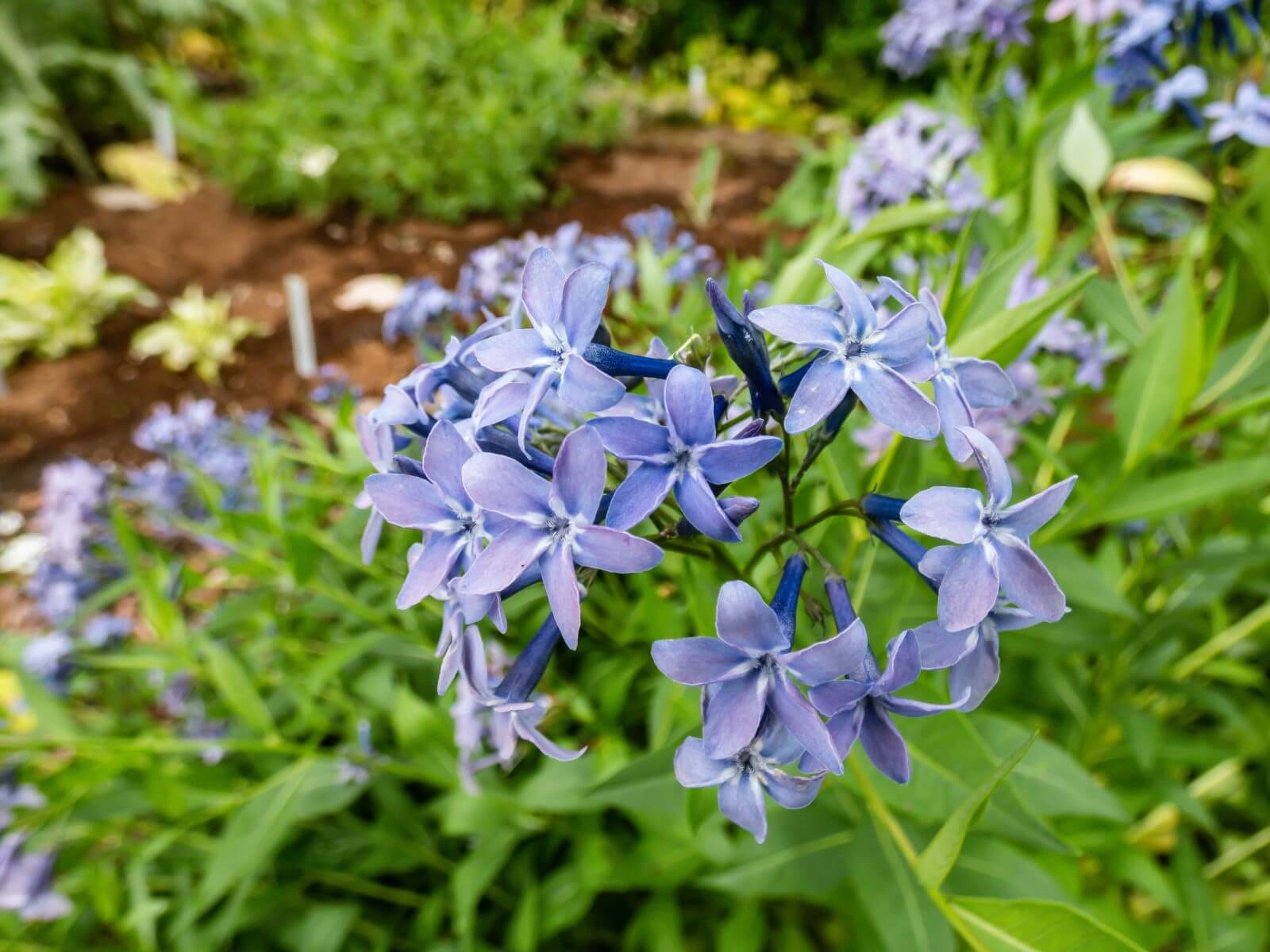
Bluestar, also known as Amsonia, is a fascinating plant that captivates with its striking blue flowers and elegant foliage. This perennial beauty has evolved over time, adapting to various climates and habitats around the world. In this article, we will delve into the intriguing world of Bluestar and uncover 13 fascinating facts that will pique your curiosity and deepen your appreciation for this stunning plant. From its medicinal uses to its role in butterfly conservation, Bluestar has much to offer both in terms of aesthetics and ecological value. So, let’s embark on this botanical adventure and discover the wonders of Bluestar!
Key Takeaways:
- Bluestar, also known as Amsonia, is a stunning and low-maintenance perennial plant native to North America. It attracts pollinators, offers medicinal benefits, and symbolizes hope and calmness in the language of flowers.
- With its vibrant blue flowers, deer-resistant nature, and unique seed pods, Bluestar is a versatile and hardy plant that adds beauty and interest to any garden or landscaping project.
Origin of the Name
Bluestar, also known as Amsonia, gets its name from the stunning blue star-shaped flowers it produces.
Native to North America
Bluestar is native to North America and can be found growing in various regions, from Canada to Mexico.
Perennial Beauty
Bluestar is a perennial plant, meaning it lives for more than two years and comes back year after year with its beautiful display of flowers.
Drought-Tolerant
Bluestar is known for its ability to tolerate drought conditions, making it a resilient and low-maintenance addition to any garden.
Attracts Pollinators
The vibrant blue flowers of Bluestar attract pollinators such as bees and butterflies, making it a valuable plant for supporting local ecosystems.
Medicinal Uses
Bluestar has been used in traditional medicine for its various therapeutic properties, including its potential anti-inflammatory and analgesic effects.
Versatility in Landscaping
Bluestar can be a versatile addition to any landscaping project, as it can be used as a border plant, in rock gardens, or even as a tall, dramatic focal point.
Beautiful Fall Foliage
In addition to its striking blue flowers, Bluestar also offers beautiful fall foliage, with its leaves turning shades of golden yellow before winter.
Deer-Resistant
One of the benefits of growing Bluestar is that it is deer-resistant, making it less appealing to hungry wildlife that may ravage other plants in the garden.
Low Maintenance
Bluestar is a low-maintenance plant, requiring minimal care once established. It is a great choice for busy gardeners looking for a plant that thrives with little intervention.
Hardy Plant
Bluestar is a hardy plant that can withstand a range of temperatures and climates, making it suitable for gardeners in different regions.
Unique Seed Pods
After the flowers have faded, Bluestar produces interesting seed pods that often persist into the winter, adding texture and visual interest to the garden.
Symbolic Meaning
In the language of flowers, Bluestar symbolizes hope, inspiration, and a sense of calmness – qualities that can be reflected in your garden or floral arrangements.
So there you have it – 13 intriguing facts about Bluestar. Whether you are a fan of its vibrant blue blooms, its low-maintenance nature, or its versatility in landscaping, Bluestar is definitely a plant worth considering for your home or garden.
Conclusion
Bluestar, also known as Amsonia, is a fascinating and versatile plant. From its stunning blue flowers to its ability to attract butterflies, there is much to admire about this perennial. Its unique characteristics make it a great addition to any garden or landscape.Whether you are an avid gardener or just starting out, incorporating Bluestar into your plant collection will surely add beauty and interest. With its low-maintenance nature and ability to thrive in various conditions, it is a plant that can be enjoyed by beginners and experienced gardeners alike.So, why not consider adding Bluestar to your garden? With its intriguing features and ability to enhance any landscape, it is a plant that will surely captivate your attention and bring joy for years to come.
FAQs
1. What is the ideal growing environment for Bluestar?
Bluestar thrives in full sun to partial shade and prefers well-draining soil. It is a hardy plant that can tolerate a wide range of soil types, including clay and sandy soil.
2. How tall does Bluestar typically grow?
Bluestar can grow to be around 2 to 3 feet tall, making it a great choice for mid-sized gardens or as a border plant.
3. Does Bluestar require a lot of maintenance?
Bluestar is a low-maintenance plant that requires minimal care. Regular watering and occasional pruning of dead stems are usually sufficient to keep it healthy and thriving.
4. Can Bluestar attract pollinators?
Yes, Bluestar is known to attract butterflies and other pollinators with its beautiful blue flowers. Adding this plant to your garden can help create a welcoming environment for these beneficial insects.
5. Is Bluestar deer-resistant?
Yes, Bluestar is typically deer-resistant, making it a good choice for gardens located in areas with deer populations.
6. Can Bluestar be grown in containers?
Yes, Bluestar can be grown in containers, but it is important to choose a pot that provides adequate drainage as the plant prefers well-draining soil.
7. When is the best time to plant Bluestar?
The best time to plant Bluestar is in spring or fall when the temperatures are mild. This allows the plant to establish its roots before the extreme heat of summer or cold of winter.
8. Does Bluestar have any medicinal uses?
Bluestar has been used in traditional medicine for its potential anti-inflammatory and anti-spasmodic properties. However, it is important to consult a healthcare professional before using it for medicinal purposes.
9. Can Bluestar be divided?
Yes, Bluestar can be divided every few years to rejuvenate the plant. This is typically done in early spring or fall, and it helps maintain the plant’s health and vigor.
10. Are there any companion plants that go well with Bluestar?
Bluestar pairs well with other perennials such as coneflowers, salvia, and ornamental grasses. The contrasting colors and textures create a beautiful and harmonious garden display.
11. Does Bluestar have any cultural significance?
Bluestar is a native plant in North America and holds cultural significance for some Native American tribes. It has been used in traditional ceremonies and is regarded as a symbol of harmony and balance.
12. Can Bluestar be propagated from seeds?
Yes, Bluestar can be propagated from seeds. However, it may take a few years for the plant to reach maturity and start blooming.
13. How long does the blooming period of Bluestar last?
The blooming period of Bluestar typically lasts for several weeks in late spring or early summer. The beautiful blue flowers add a vibrant splash of color to the garden during this time.
Was this page helpful?
Our commitment to delivering trustworthy and engaging content is at the heart of what we do. Each fact on our site is contributed by real users like you, bringing a wealth of diverse insights and information. To ensure the highest standards of accuracy and reliability, our dedicated editors meticulously review each submission. This process guarantees that the facts we share are not only fascinating but also credible. Trust in our commitment to quality and authenticity as you explore and learn with us.


